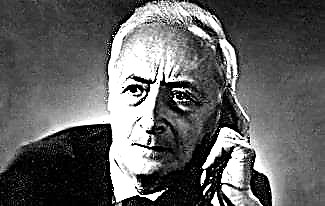From an everyday standpoint, sleep is most easily defined as rest. In the waking state, we act with varying degrees of intensity, do some work, in general, we behave actively, accumulating fatigue. Then rest time comes and we sleep. If we're lucky, sleep gives us effective rest, but it so happens that after waking up a person feels worse than he was before going to bed.
This is approximately how sleep and science have defined until recently. But in the second half of the twentieth century, the development of somnology - the science of sleep and its disorders - led to the fact that the definition of sleep only as rest began to contradict the scientific data obtained. Somnology, like any young science, is constantly faced with new discoveries and observations that complicate things that previously seemed obvious. This is probably why somnologists prefer to avoid clear definitions. According to the modern definition, sleep is "a special genetically determined state of the mammalian organism, characterized by a consistent regular change of certain polygraphic pictures in the form of cycles, phases and stages." The word "printing", in this case, does not refer to the method of printing, but shows that the picture of sleep is illustrated by graphs of electrical impulses coming from different parts of the body. As we see, there is no mention of rest, only genetics, cycles and phases.
Some of the facts and stories below show that somnology has advanced quite far in the study of the physiological mechanisms of sleep with the help of precision instruments, but the applied application of this science remains rather limited. Somnologists treat the same insomnia, in fact, by enumerating options, profoundly declaring that "to eliminate insomnia, you need to eliminate its cause." In the same way, Ostap Bender argued that in order to eliminate dreams of Soviet power, Soviet power must be eliminated. And from reports about people who have not slept for years, somnologists get rid of statements about the impossibility of such a phenomenon.
It turns out that we all sleep, we know very little about sleep, and we practically do not know how to influence sleep at all.

1. Sleep in the special bedrooms we are accustomed to has come into the everyday life of a person relatively recently. Moreover, the spread of bedrooms is not associated with the development of any people or country, but exclusively with the property well-being of people. In one of the first known bedrooms, the sun king Louis XIV rested. The king certainly had the opportunity to allocate special rooms for himself, not only for sleeping, but also for other activities. However, Louis' bedroom was, rather, a converted study, in which they put a huge bed. There was no question of any privacy: the servants did not leave the bedroom at all, and the first visitors broke into the room, as soon as the king opened his eyes. Even natural necessities in the morning Louis sent out, talking with the closest nobles. Gradually, separate bedrooms - male and female - began to appear among aristocrats. Even in the middle of the 19th century, ordinary people slept in one bed for all, more like a platform. Sleep began to acquire some intimacy among the broad masses only in the twentieth century, with a gradual rise in the standard of living of the broad masses.
2. Genuine scientific research on sleep did not begin until the 1920s. Before that, scientists either did not see an object for study in a dream, or tried to explain the sleep process empirically. The common point of view was the belief that sleep arises from a lack of something in the body. During sleep, the reserves of this something are replenished, or a new volume is produced. Fire (as one of the four basic elements), heat, blood, perfume, food, oxygen, creatine, lactic acid, etc. played the role of “something”. Hippocrates was very logical. He argued that sleep is an increase in the activity of internal organs and a weakening of external ones, that is, sleep and wakefulness are two different types of body activity.
3. The opportunity to study sleep on a scientific basis, that is, with the fixation of results and the ability to repeat research, appeared with the discovery of electrical brain waves by the English scientist Richard Cato. In the 1920s, the German physician Hans Berger was able to record electrical brain waves for the first time with the help of equipment that was very primitive even at that time, having received the first EEG - an electroencephalogram of the brain. For the first time, Berger was able to compare the EEG of a waking and sleeping person, and also explored some intermediate states, such as intense mental work or being under hypnosis. Alpha brain waves with a frequency of 8-12 Hz are called Berger waves.
4. Almost all peoples, the language of which has developed to the presence of sayings, have established expressions that urge to go to bed earlier and get up earlier. Based on the prevalence of these sayings, we can conclude about some thousand-year-old wisdom contained in them. However, many years of research have shown that the duration of sleep is of fundamental importance, and not the time of its beginning and end. The time of falling asleep and waking up, ideally, should coincide with the individual biorhythms of a person - everyone knows about "owls" and "larks".
5. Experiments show that sleep and lack of sleep have a profound effect on brain function. In one study, people who learned the same set of foreign words were divided into two groups. Participants in one of them slept, members of the second group were awake for 36 hours. After this time, it turned out that the awake participants in the experiment were able to remember 40% fewer words. An interesting experiment was carried out with music lessons for non-professional musicians. The lesson learned in the morning did not make any changes to the subjects' play when tested in the evening. But the evening lesson after sleep significantly improved the participants' game.
6. With the help of electroencephalograms of the brain, it was quickly established that the average person's sleep consists of cycles lasting 90-100 minutes. In each cycle, a person goes through phases of slow and rapid sleep. Slow sleep is divided into 4 stages, but fundamentally they do not differ - this is a rather smooth slide into deep sleep. REM sleep, or REM sleep (from the English rapid eyes movement - "rapid eye movements", the famous rock band also named by this abbreviation) in each cycle occurs last and is characterized by rapid eye movements and a drop in muscle tone. Due to the fact that brain activity during this period is similar to wakefulness, but muscle work is minimal, and it is most difficult to wake a person up, muscle sleep is often called paradoxical. On average, REM sleep takes up about 25% of all sleep. It is in the fast phase that a person sees the most memorable coherent dreams.

7. REM sleep was discovered by Eugene Aserinsky, a collaborator of the “father of sleep research” Nathaniel Kleitman, who was actually Eugene Aserinsky. The Brooklyn native miraculously landed a postgraduate position at the University of Chicago. The administration shoved him off to Kleitman, whose entire work with graduate students was limited to the distribution of assignments, so that they would get rid of him and did not interfere with his own research. He sent Azerinsky to count the frequency of blinking in sleeping babies. After completing this work, the graduate student received a new one: to count the frequency of blinking in falling asleep adults. They didn’t like sleeping in the light, nor the fact that in the twilight someone was peering into their faces. Azerinsky found an ancient broken encephalograph in the warehouse, with the help of a friend, repaired and calibrated it, and rather quickly discovered incomprehensible brain waves and eye movements in people who were fast asleep. Kleitman brushed aside such a discovery. But Azerinsky needed a doctorate - a family with two children lived from hand to mouth - and he continued to convince his boss that his observations were correct. In the end, he gave up. Having received a new encephalograph, Azerinsky recorded the results of the research. Clayton graciously took him on as a co-author of the revolutionary work published in Science, but instead expelled the discoverer from the University of Chicago, receiving almost all the laurels.
8. Dreams are seen by absolutely all people, even the blind, but not everyone remembers them. It's about the time of awakening. Among people who woke up or woke up in the phase of slow sleep, at least 7% will remember the dream, and among those who woke up in the fast phase - 80%. If we consider that a full sleep consists of at least 4 cycles, it is obvious that everyone sees dreams. Necessary clarification: many "dreams" in the phase of slow sleep are a collection of several incoherent images, and not coherent plots.
9. Somnambulism, or sleepwalking, has been known for thousands of years. Chilling stories about people walking in a dream on narrow cornices or roof ridges on a full moon are known to everyone. In fact, this disease has nothing to do with the Moon. Most likely, in the old days, in the absence of street lighting, it was easiest to see lunatics at the full moon, so the visible connection was fixed in the public consciousness. The phenomenon of somnambulism is not uncommon. On the contrary, in boys 11-13 years old it occurs en masse, in girls of the same age it is much less common. This, of course, is not about roofs and cornices - teenagers, without waking up, perform complex actions that require reflection: they can go to the toilet, leave the apartment by unlocking the door, take something from the refrigerator. After waking up, they do not remember what they did in their sleep. The earlier sleepwalking appears in children, the more likely it will recur after growing up. This is where things can go to extremes in the form of climbing trees and fences, swimming and overcoming serious obstacles. The dexterity of sleepwalkers is simply explained - there is no fear and nervous tension that fetters a person's actions in a state of wakefulness.
10. The center of sleep in the human body is located in the hypothalamus of the brain. It is a very small group of neurons that are dormant when a person is awake. During slow wave sleep, these neurons secrete gamma-aminobutyric acid, which inhibits the activity of the brain. This continues until the trigger located right there, in the hypothalamus, is triggered. The sleep center neurons are turned off and the person enters REM sleep. It is possible that malfunctions of this trigger explain some cases of extra long sleep - the brain freezes in a transitional state, and the person continues to sleep deeply.
11. We have three eyes when we want to sleep in the evening, and we barely "tear" them, waking up in the morning, for the same reason - much fewer tears stand out in a dream. The body reduces their number in preparation for sleep, and greatly decreases after falling asleep. But the movement of the eyeballs continues, albeit with less intensity. By the morning my eyes dry up. This is the most obvious change in the body's activity. In addition, in a dream, the body temperature drops, breathing slows down and the pulse decreases blood pressure, skin reactions weaken.
12. Sleep learning - hypnopedia is not quackery, but it is not a proven methodology either. In some cases, under certain (not completely clear) conditions, indeed, people managed to remember in a dream such difficult things to memorize as traffic schedules, extensive numerical tables or arrays of foreign words. However, it was not possible to achieve repeatability of these successes. They found out that effective memorization occurs only in the first of the four parts of slow wave sleep. It is deliberately impossible to stay in this phase, medication or hypnotic intervention transfers the experiment to another plane. Therefore, "Learning foreign languages in a dream" with a guaranteed result is pure fraud. Hypnopedia is well illustrated in the animated TV series Ventura Brothers. There, the brothers happily took a course in their sleep, but they were very surprised when they were awarded diplomas, too, in their sleep.
13. Most adults need 7-9 hours of sleep. However, this is an average indicator with large deviations in both directions. Albert Einstein, by conventional standards, was a bum and lazy person - he usually slept at least 10 hours a day. The inventor Nikola Tesla, during the period of intensive work, was content with 3 hours of sleep. Then came a period of relaxation, and Tesla slept off without getting out of bed for 10-12 hours. Leonardo Da Vinci did not have a night's sleep in our understanding. Several times a day he fell asleep for 15-20 minutes, and this was enough for a good rest. Benjamin Franklin and Napoleon Bonaparte slept for 4 hours on average, although the latter made up for lost time in exile. Ladies, Napoleon, who knew a lot about a weak field, advised to sleep at least 8 hours. 3 hours of sleep on the hikes was enough for Julius Caesar. The anecdote looks like the statement about 5-hour sleep (and in two runs - day and night), which Winston Churchill managed. At the same time, in the mass of memoirs, the authors write how twice the Prime Minister of Great Britain could doze off at a meeting of the Cabinet of Ministers or even during hearings in Parliament.
14. Back in the late 19th century, scientists in different countries began to experimentally investigate how long a person can go without sleep. The results were about the same - 90 hours are the critical milestone. Beyond this border a person, of course, does not die, but he loses the ability for meaningful activity. Hallucinations begin, orientation in space is gradually lost. After about the same period of time, the personality completely disintegrates - the person ceases to be aware of himself, hallucinations turn into nightmares. Interestingly, in some experiments, the brains of formally awake subjects, after 180 hours without sleep, began to emit delta waves, indicating a state of sleep. The body began to produce steroids, potassium, sodium and indoles, the effect of this mixture is similar in symptoms to the effect of LSD. Fortunately, all participants in the experiments came to their senses after 12 - 16 hours of sleep. Somewhat aside is the experience of the American scientist William Dement, who at one time participated in the initial research on REM sleep. In 1965, his ward Randy Gardner spent 11 days without sleep. At the end of the experiment, Gardner took part in a press conference, during which, proving the adequacy of his condition, he carved an animal figurine from wood. However, the experiment with Gardner does not look very correct: he was observed by several specialists, he himself, despite his youth, was a very strong-willed person. Finally, Dement later admitted that he and his colleagues deliberately thrashed Gardner to keep him awake.
15. A patient with narcolepsy, a disease caused by a lack of orexin in the body, can fall asleep up to 200 times a day. The insidiousness of this disease is that it affects only young men who lead an active lifestyle. People with narcolepsy are well aware that they have just fallen asleep for a few seconds or minutes literally on the go, but they attribute this to overwork at work, too violent night entertainment or the need for good rest. Narcolepsy is usually accompanied by insomnia, so hopes that “I'll get enough sleep and everything will pass” are unfounded. The diagnosis of narcolepsy is very difficult - a comprehensive psychological and medical examination is required, which takes several days. The situation is aggravated by the unclear heredity of the disease and the lack of precise methods of treatment. While narcolepsy is being treated with psychostimulants and antidepressants.

sixteen.In about 31% of men and 19% of women, sleep is accompanied by snoring of varying volume. Snoring has long been the subject of anecdotes, but in reality this problem is too serious to be left to humorists. Snoring begins in deep slow wave sleep (phase IV) and should end with the onset of REM sleep. However, this is just a theory. In practice, the human body is affected not only by factors caused by sleep, but also by other characteristics of the body. Excess weight, problems with the respiratory tract, allergies, combined with relaxing sleep factors, make a person snore even louder during REM sleep. There is still no therapeutic solution to the problem of snoring - doctors limit themselves to recommendations to lose weight or to sew a tennis ball to the back of pajamas so as not to sleep on the back.
17. There are people who know everything about dreams. This is the so-called. interpreters of dreams. They explain the meaning of any dream, and if the explanation is inaccurate, this is not their fault, but the client's misfortune - dreams must be memorized accurately and in all the smallest details. Dreams were interpreted already in Ancient Greece, and the first written dream book also appeared there. Today's interpreters do not shy away from modern technologies - on the first page of the search engine search query “interpretation of dreams is charlatanism”, the search engine user receives not criticism of interpreters, but links to pages with text like “if you dreamed of a charlatan, then ...”









